Study on the Earth Pressure during Sinking Stage of Super Large Caisson Foundation
Abstract
:1. Introduction
2. Overview of Changtai Yangtze River Bridge
2.1. General Description
2.2. Geological Conditions
2.3. Sensor Arrangement
2.4. Soil Excavation Procedure
3. 3-D Finite Element Numerical Analysis
3.1. 3-D Calculating Model
3.2. Calculating Results Analysis
3.2.1. Sinking Amount of Caisson Foundation by Soil Excavation
3.2.2. Distribution Characteristics of Earth Pressure
3.2.3. Average Earth Pressure in Different Area
4. Analysis of Monitoring Data
4.1. The Sinking Amount with Soil Excavation Procedure
4.2. Distribution Characteristics of Earth Pressure at the Foot Blade
4.3. The Average Earth Pressure with Each Step of Soil Excavation
4.4. Distribution Characteristics of End Resistance of Caisson Foundation
5. Conclusions
- (1)
- Based on the principle of soil excavation from the inner compartment to outer compartment, the earth pressure at the foot blade was transferred from the inner compartment to outer compartment of the caisson foundation, and the earth pressure in the outer bulkhead became bigger and bigger, until the soil in the outer areas reached failure state, which caused apparent sinking of caisson foundation. After completing the first stage of soil excavation, the soil in the outer area almost undertook the overall weight of the caisson foundation.
- (2)
- In the sinking process by soil excavation, the variation of the end resistance was the same with that of the earth pressure at the foot blade. It gradually decreased in the inner partition and inner bulkhead area, on the contrary, it gradually increased in the outer partition and bulkhead area, until the end resistance reached the maximum in the outer bulkhead area.
- (3)
- The variation of earth pressure and end resistance was revealed by numerical analysis and field measured data. For the sinking process of caisson foundation, the numerical analysis can be used to initially make the soil excavation scheme, and then, it can be dynamically adjusted based on field measured data of earth pressure, which ensure the smooth and safe sinking of caisson foundation construction by soil excavation.
Author Contributions
Funding
Institutional Review Board Statement
Informed Consent Statement
Data Availability Statement
Conflicts of Interest
References
- Duan, L.C.; Yin, Q. Design and Construction of Caissons; Tongji University Press: Shanghai, China, 2006. [Google Scholar]
- Shi, Z.; Li, S.Y.; Yang, S.L.; Feng, C.B. Study on the characteristics of friction resistance and the mechanism of sudden sinking in the middle and late sinking stages of super large caisson foundation. Chin. J. Geotech. Eng. 2019, 38, 3894–3904. (In Chinese) [Google Scholar]
- Chen, X.P.; Qian, P.Y.; Zhang, Z.Y. Study on penetration resistance distribution characteristic of sunk shaft foundation. Chin. J. Geotech. Eng. 2005, 27, 148–152. [Google Scholar]
- Luo, C.Y. Settlement Monitoring and Numerical Simulation Analysis of Super-Deep and Large Caisson Foundation. Ph.D. Thesis, Southwest Jiaotong University, Chengdu, China, 2019. [Google Scholar]
- Huang, D. Study on Stress Characteristics and Surrounding Settlement of Large Caisson during Sinking Process. Ph.D. Thesis, Tianjin University, Tianjin, China, 2018. [Google Scholar]
- Li, P. Construction Technology for Deep-Water Huge Open Caisson Foundation. Ph.D. Thesis, Southwest Jiaotong University, Chengdu, China, 2017. [Google Scholar]
- Yan, F.Y.; Shi, G. Analysis of limiting soil resistance beneath cutting curb during sinking of open caisson. Rock Soil Mech. 2013, 34 (Suppl. 1), 80–87. [Google Scholar]
- Xu, W.; Chen, Z.Q.; Xu, Z.Y. Analysis of ultimate bearing capacity of ring cutting curbs on open caisson foundation bevels. J. Huazhong Univ. Sci. Technol. (Nat. Sci. Ed.) 2013, 41, 27–31+41. [Google Scholar]
- Jiang, B.L.; Ma, J.L.; Li, M.H.; Chu, J.L. Experiments on spatial stress of foot blade during caisson sinking in water. Rock Soil Mech. 2019, 40, 1693–1703. [Google Scholar]
- Zou, H.X.; Ma, J.L.; Zhang, K.; Luo, C.Y.; Yang, B. Study of sinking resistance of large and deep caisson based on centrifugal model test. Rock Soil Mech. 2019, 40, 3969–3976. [Google Scholar]
- Zhu, J.M.; Gong, W.M.; Mu, B.G.; Mi, C.J. Research on stress and settlement of super-large open caisson during first lifts. Rock Soil Mech. 2012, 33, 2055–2060+2066. [Google Scholar]
- Zhong, J.H. The In-Suit Test Study on Super-Sized Caisson Force during Sinking. Ph.D. Thesis, Southwest Jiaotong University, Chengdu, China, 2016. [Google Scholar]
- Zhang, Z.C.; Deng, Y.L.; Zheng, F.L.; Wang, J.C. Analysis on sudden sinking behaviors of massive open caisson in deep-thick soft clay area. Chin. J. Undergr. Spaceand Eng. 2020, 16, 933–943. [Google Scholar]
- Mu, B.G.; Wang, Y.; Zhu, J.M. Analysis of large caisson sinking measured resistance. J. Civ. Archit. Environ. Eng. 2012, 34 (Suppl. 1), 107–115. [Google Scholar]
- Qin, S.Q.; Yuan, R.A.; Zheng, Q.G.; Fu, Z.G.; Ma, R.P.; Xu, L.P. Research on structural systems for very long-span rail-cum-road cable-stayed bridge. Bridge Constr. 2020, 50, 1–8. [Google Scholar]
- Ma, Y.G.; Liu, Y.F.; Huang, R. Study of mechanism and early warning indexes of abrupt sinking of large open caisson in deep soft clay layers. Bridge Constr. 2019, 49, 33–38. [Google Scholar] [CrossRef]

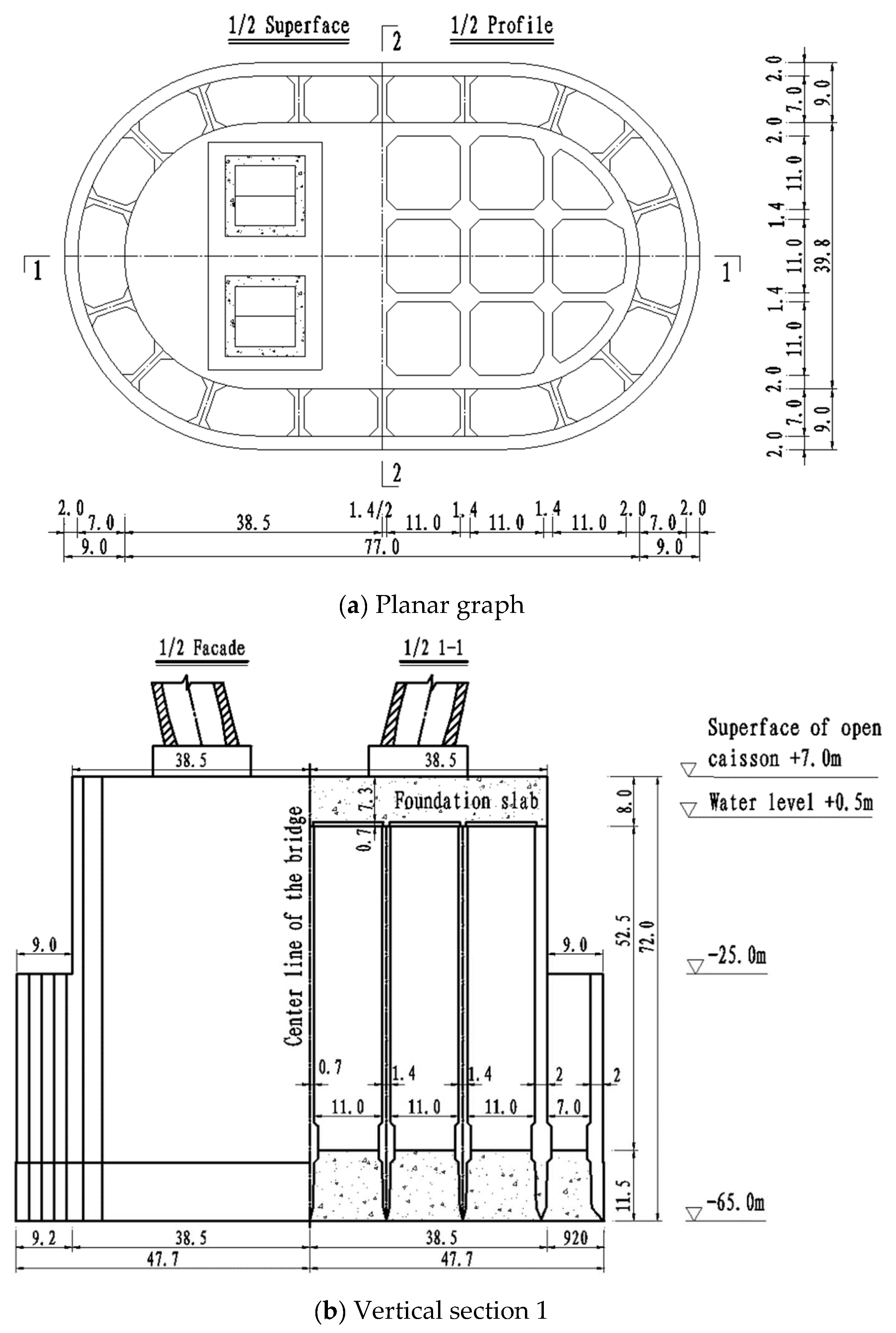
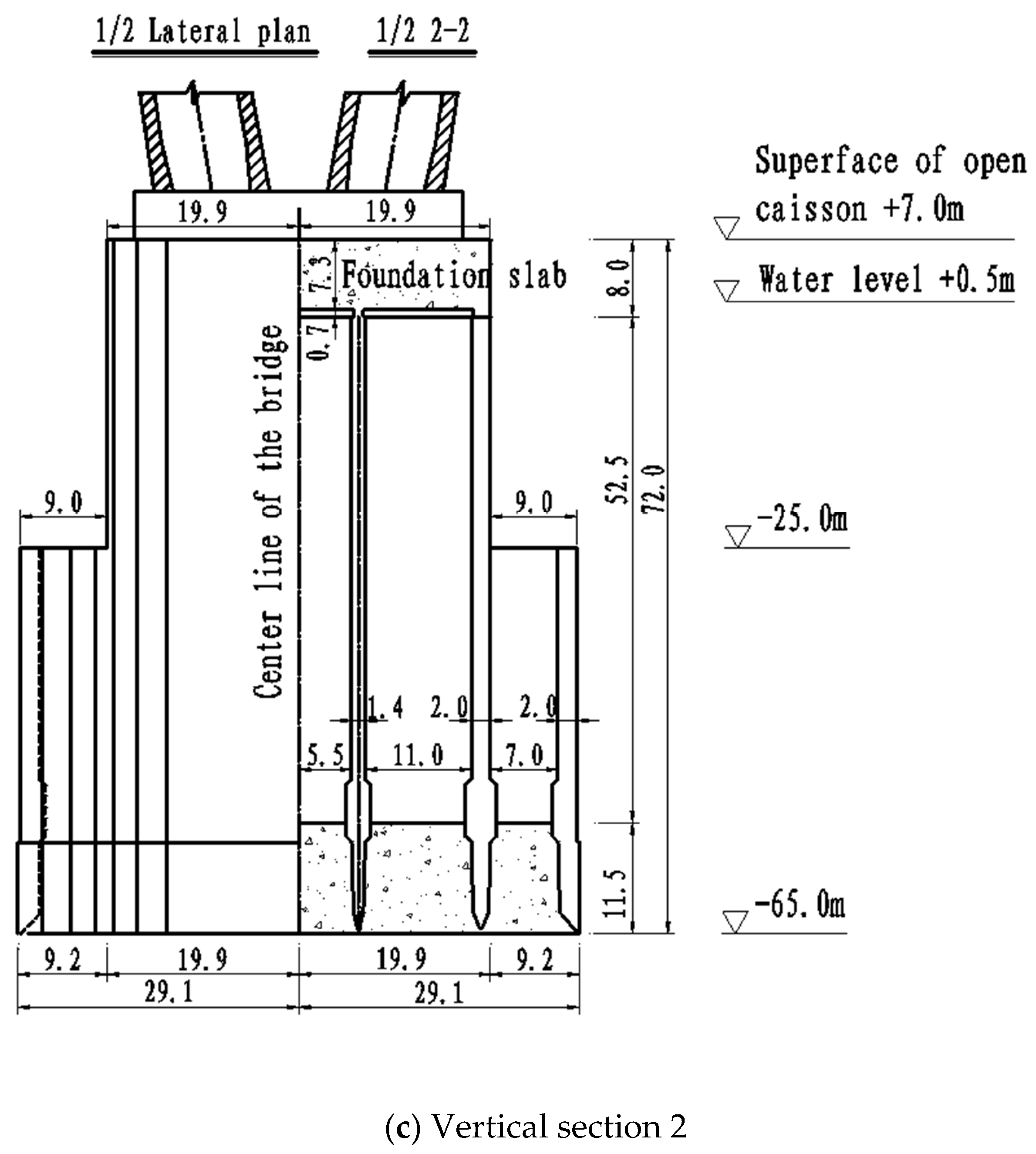

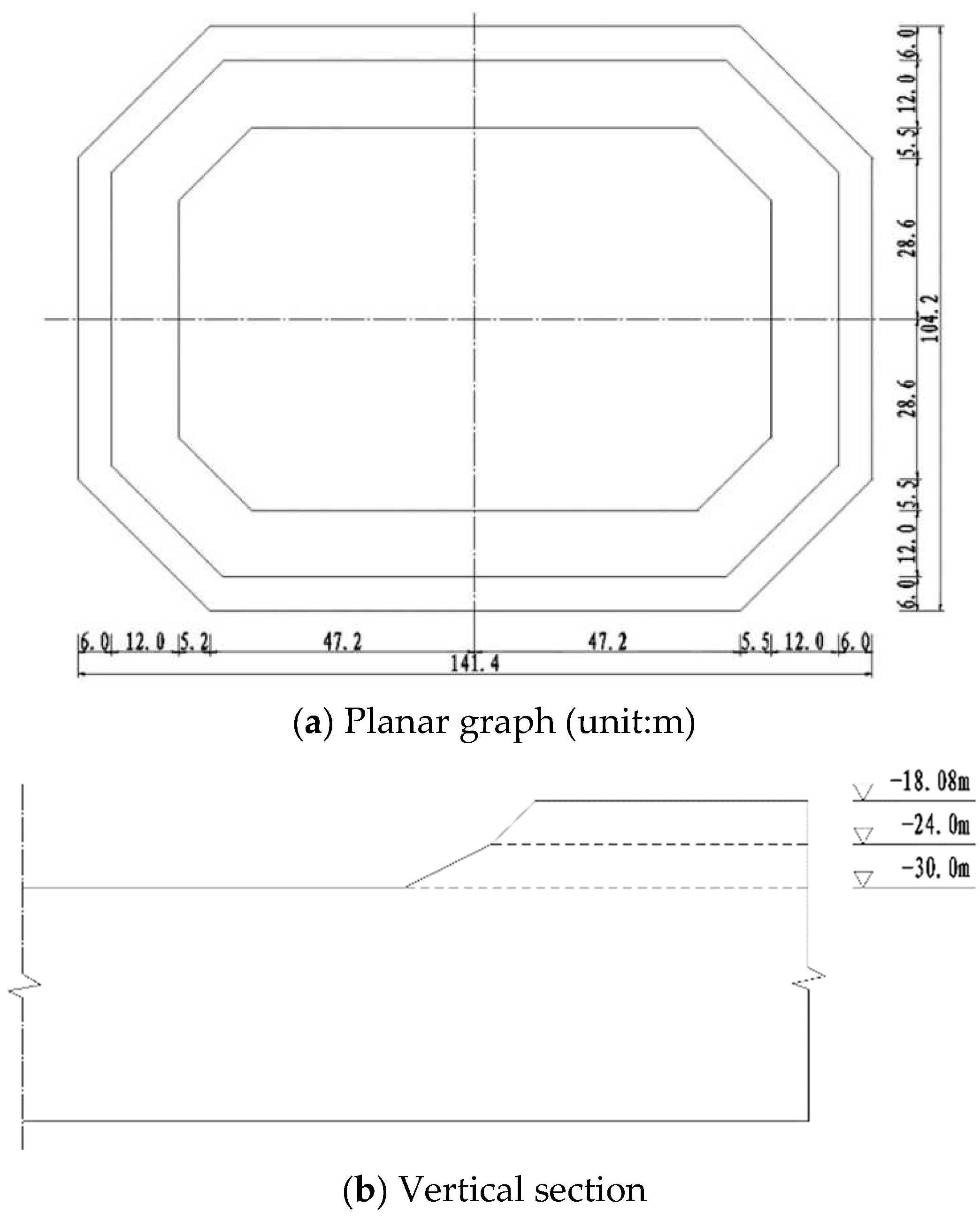
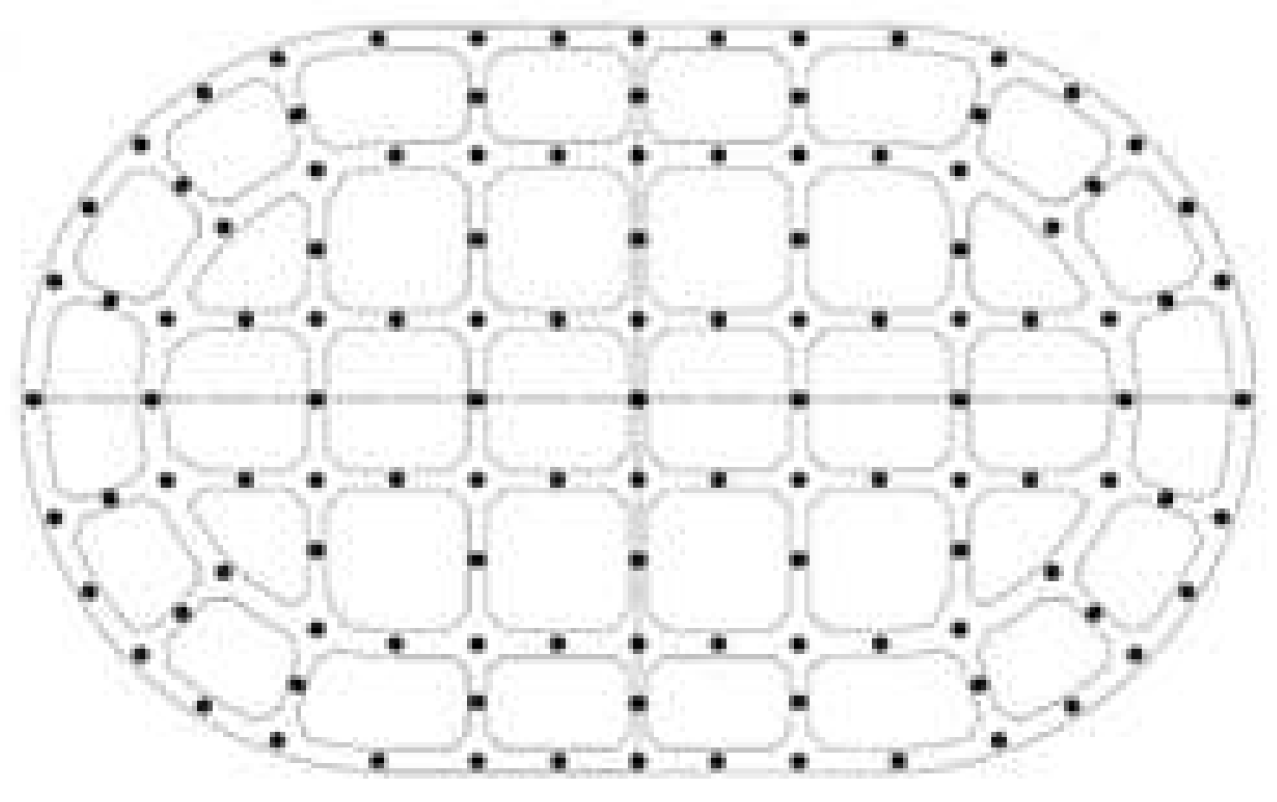
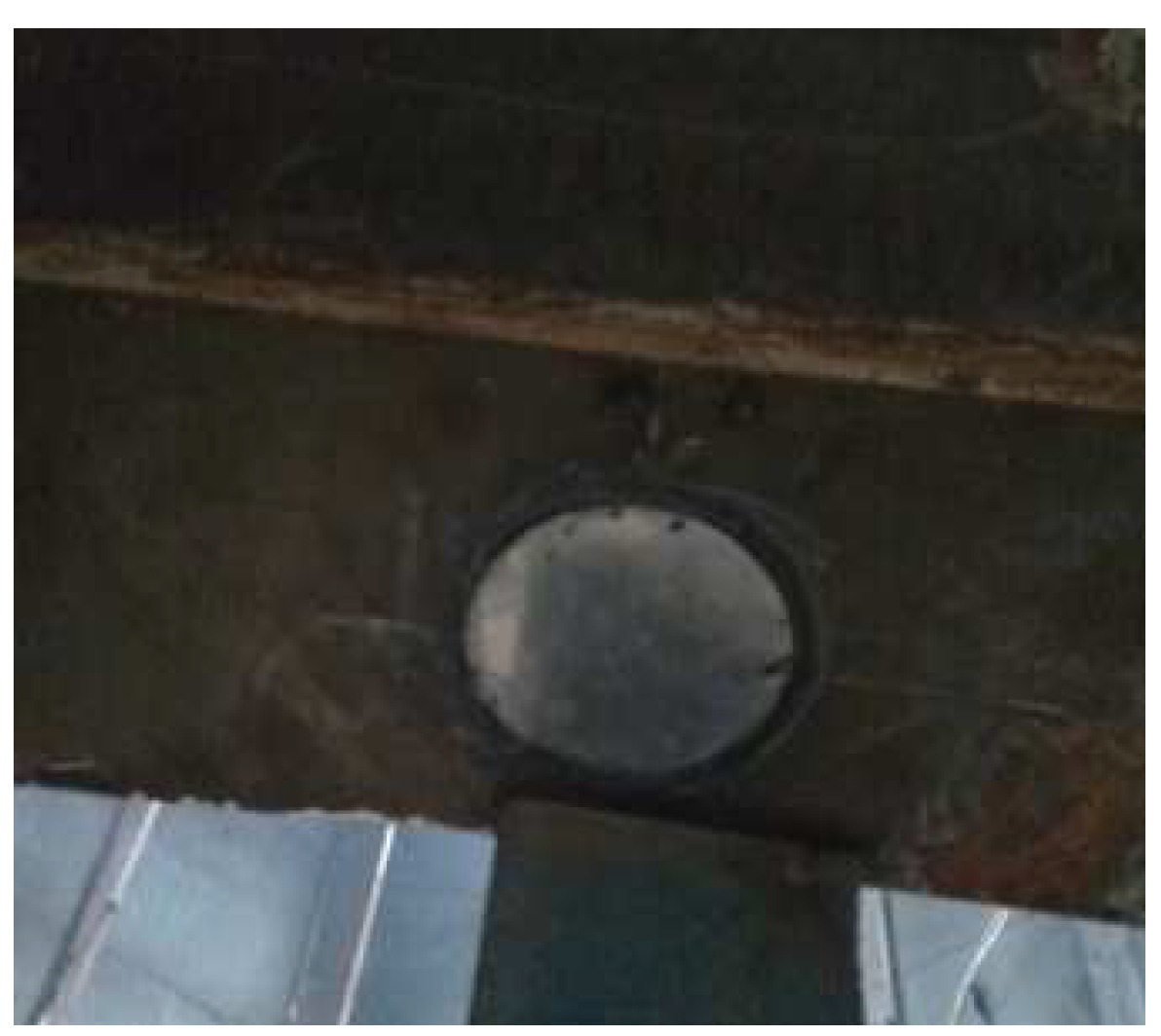

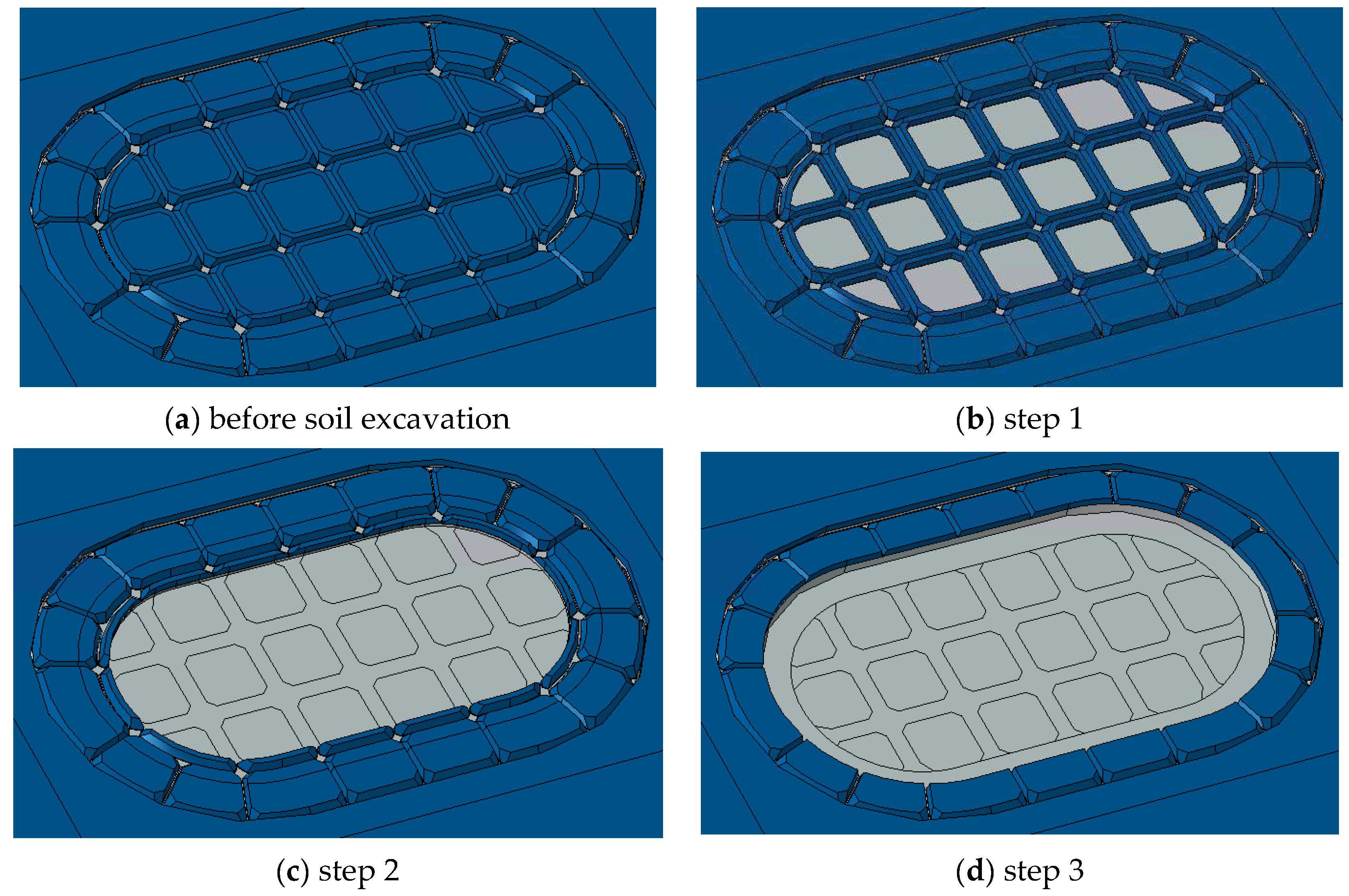
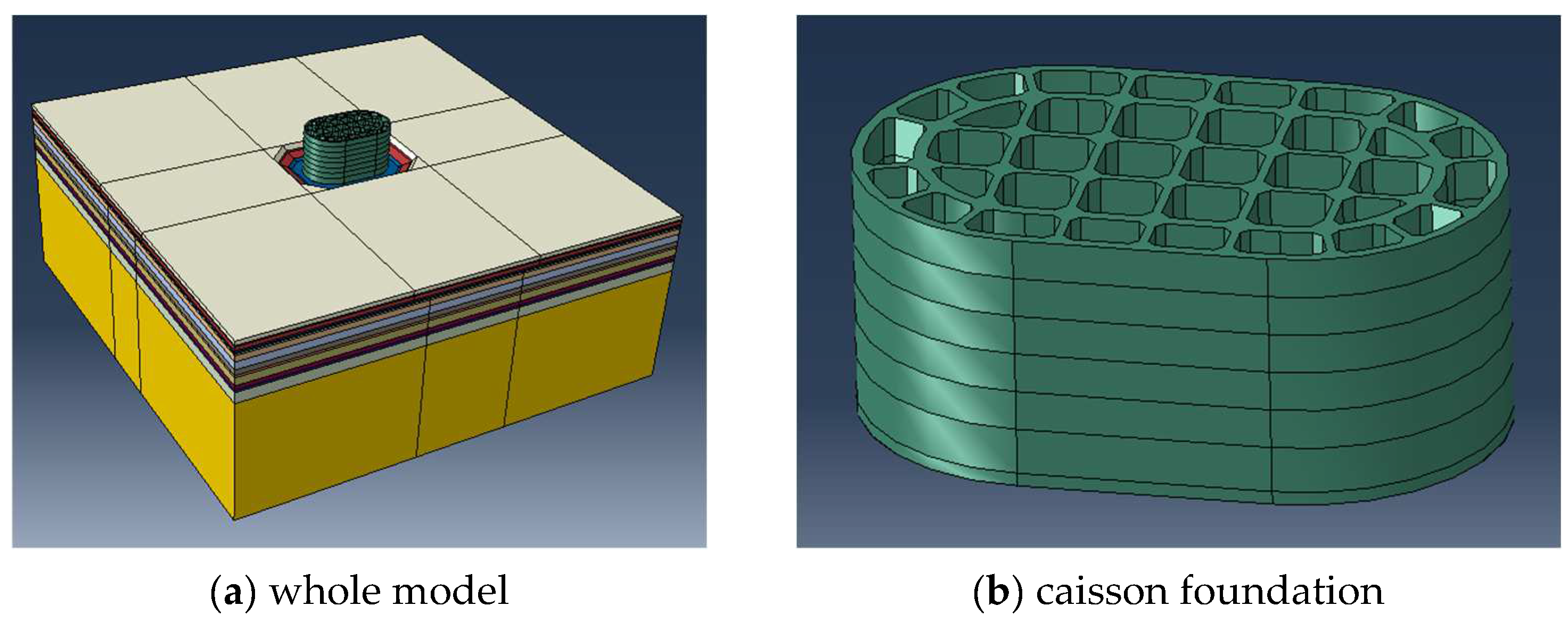
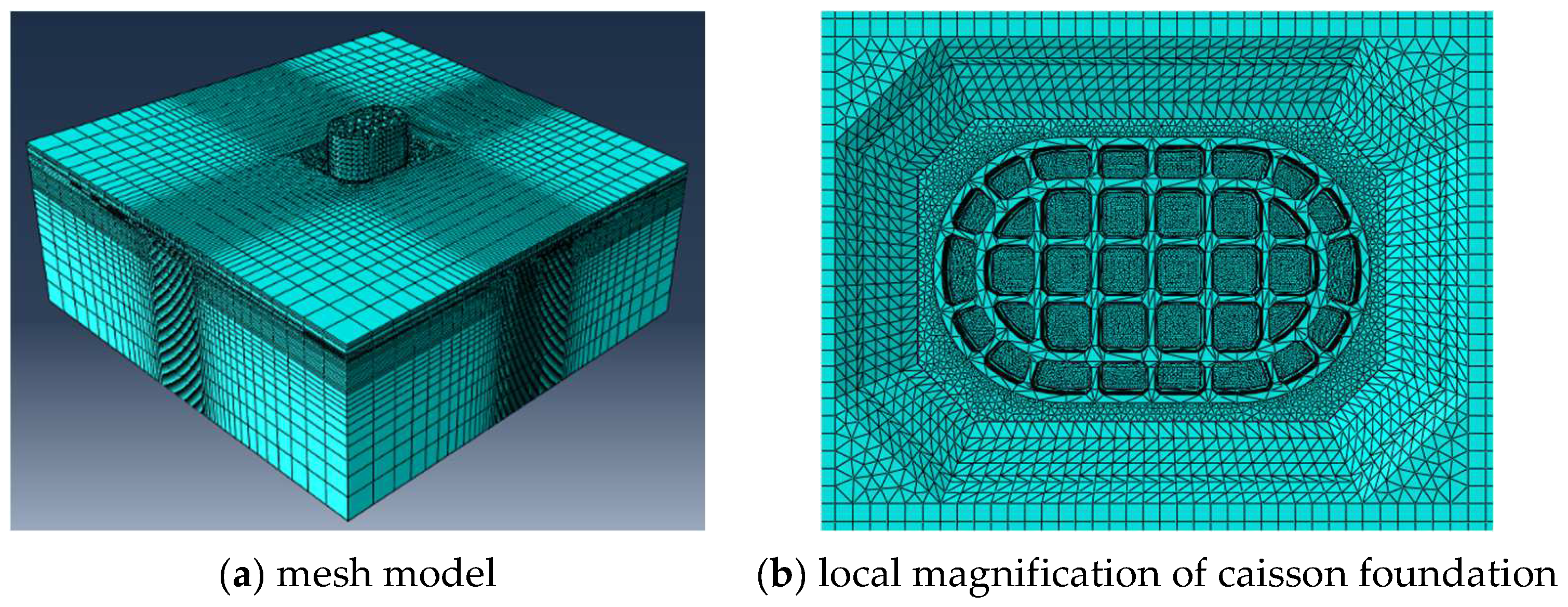
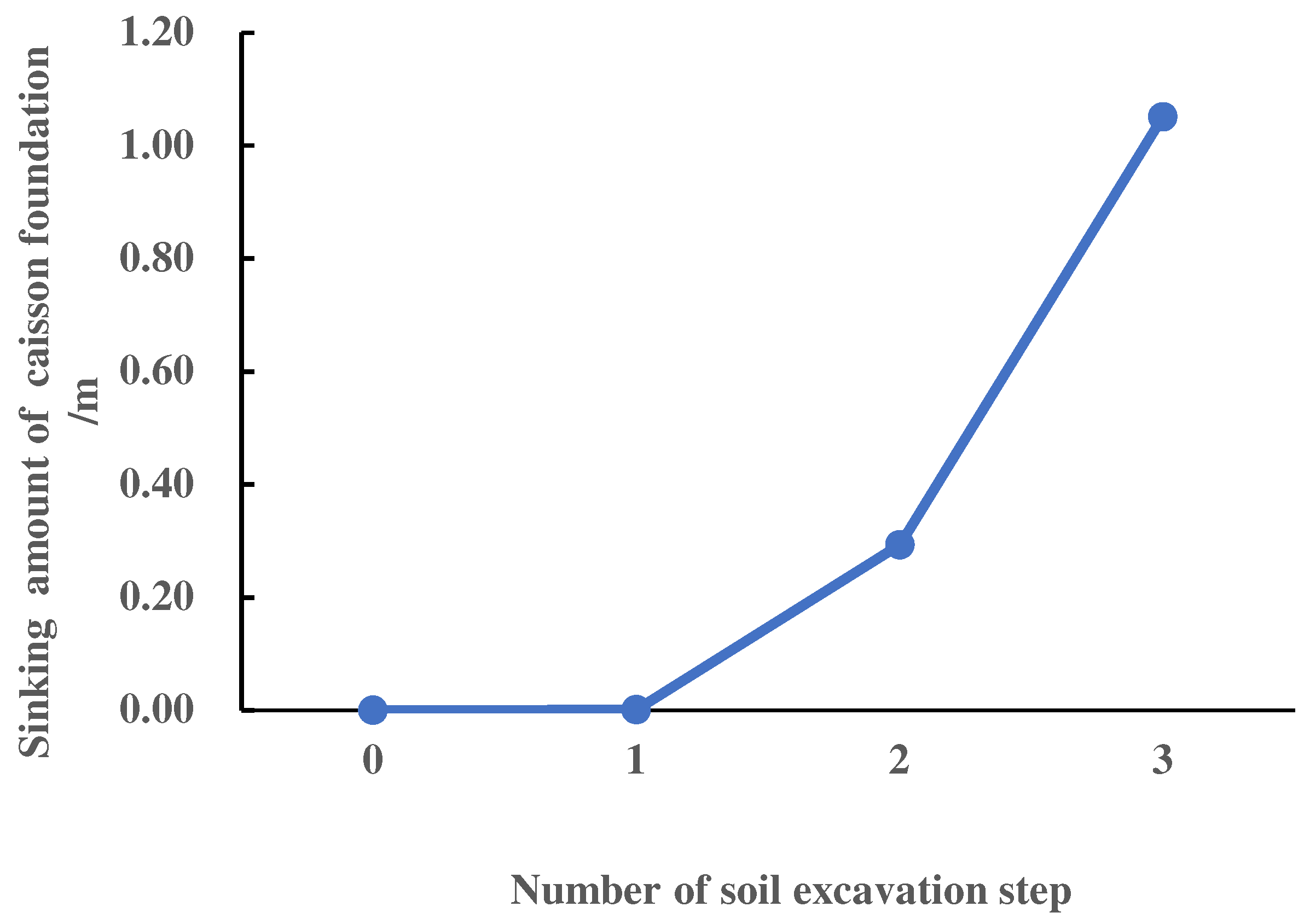
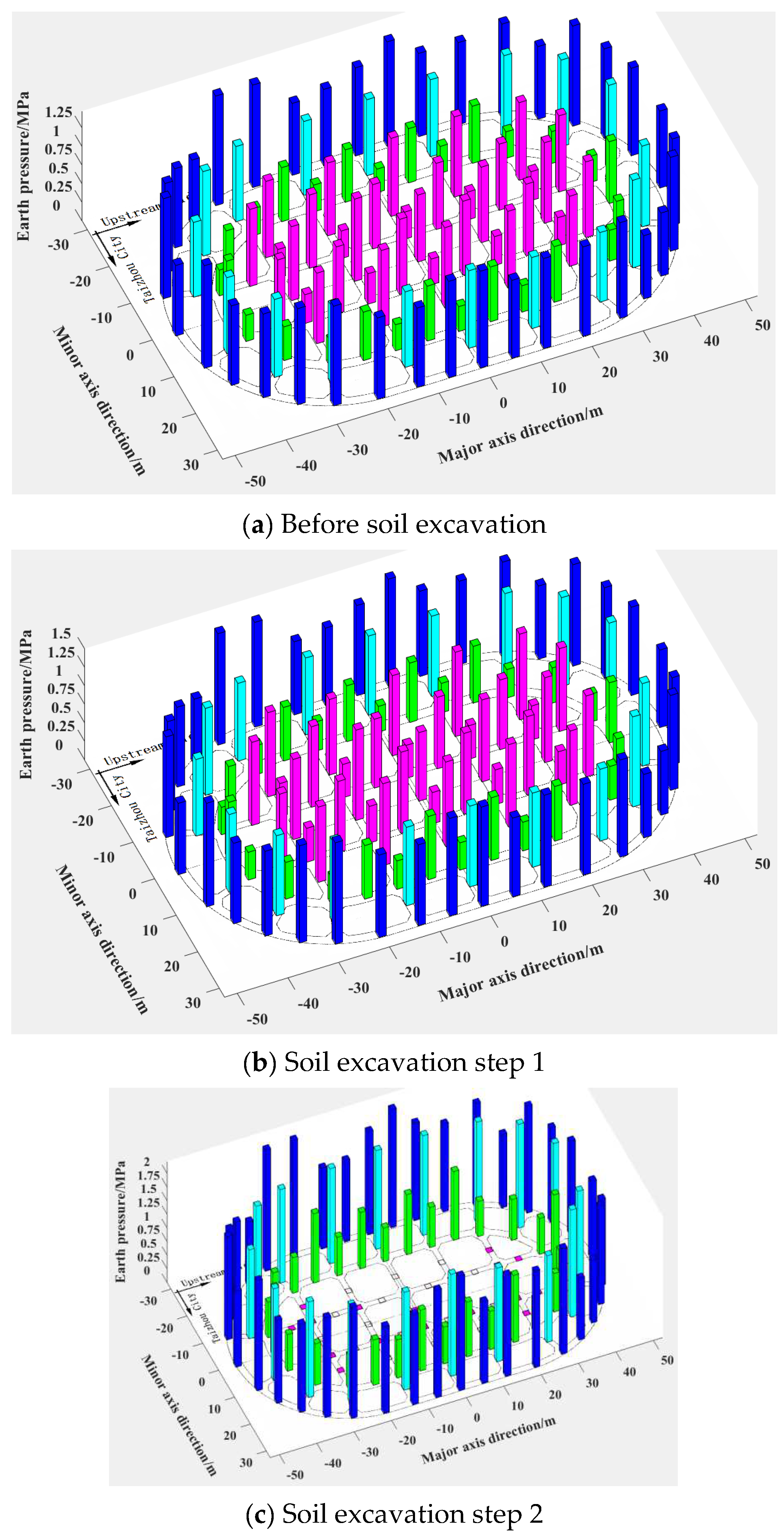
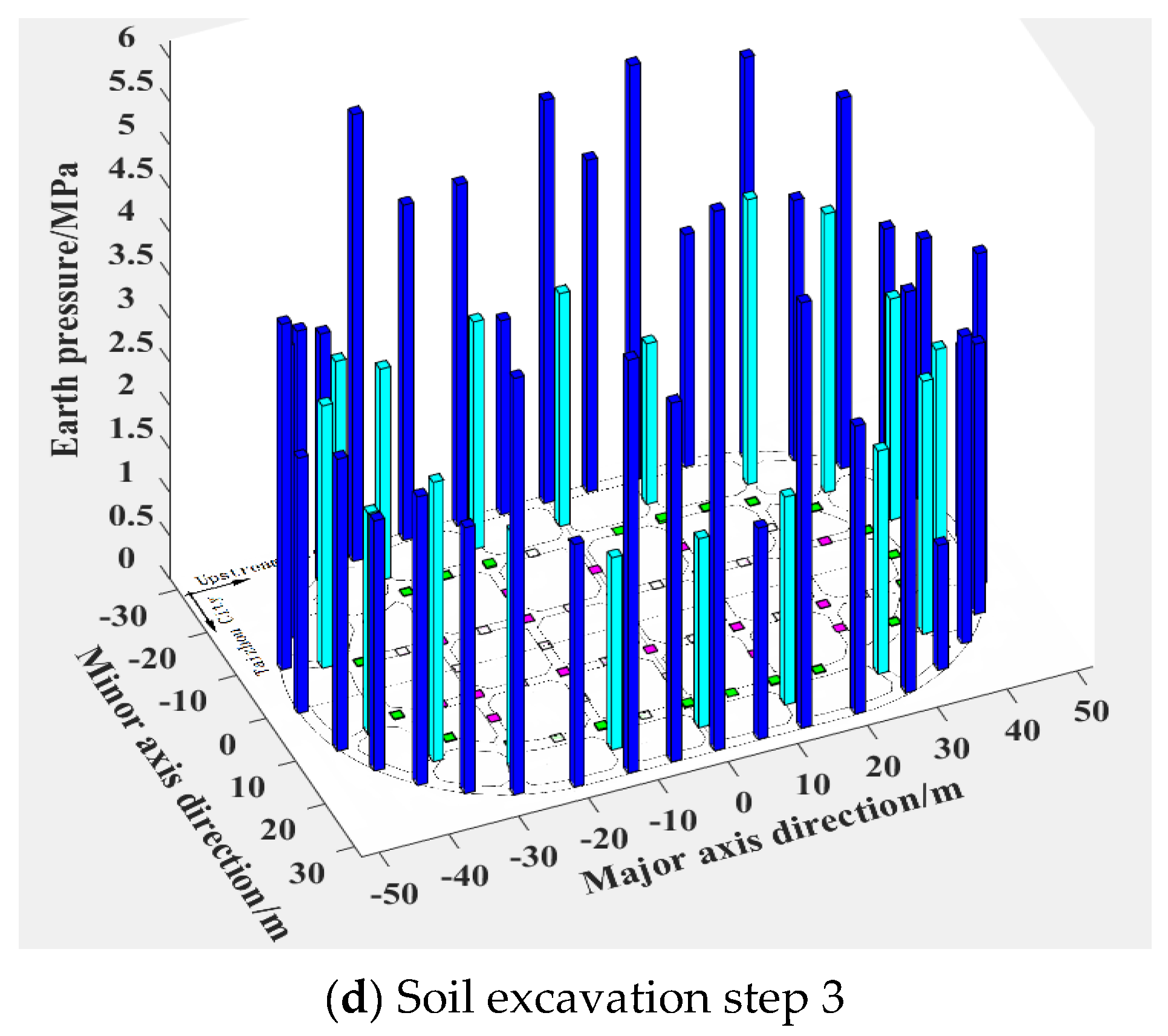
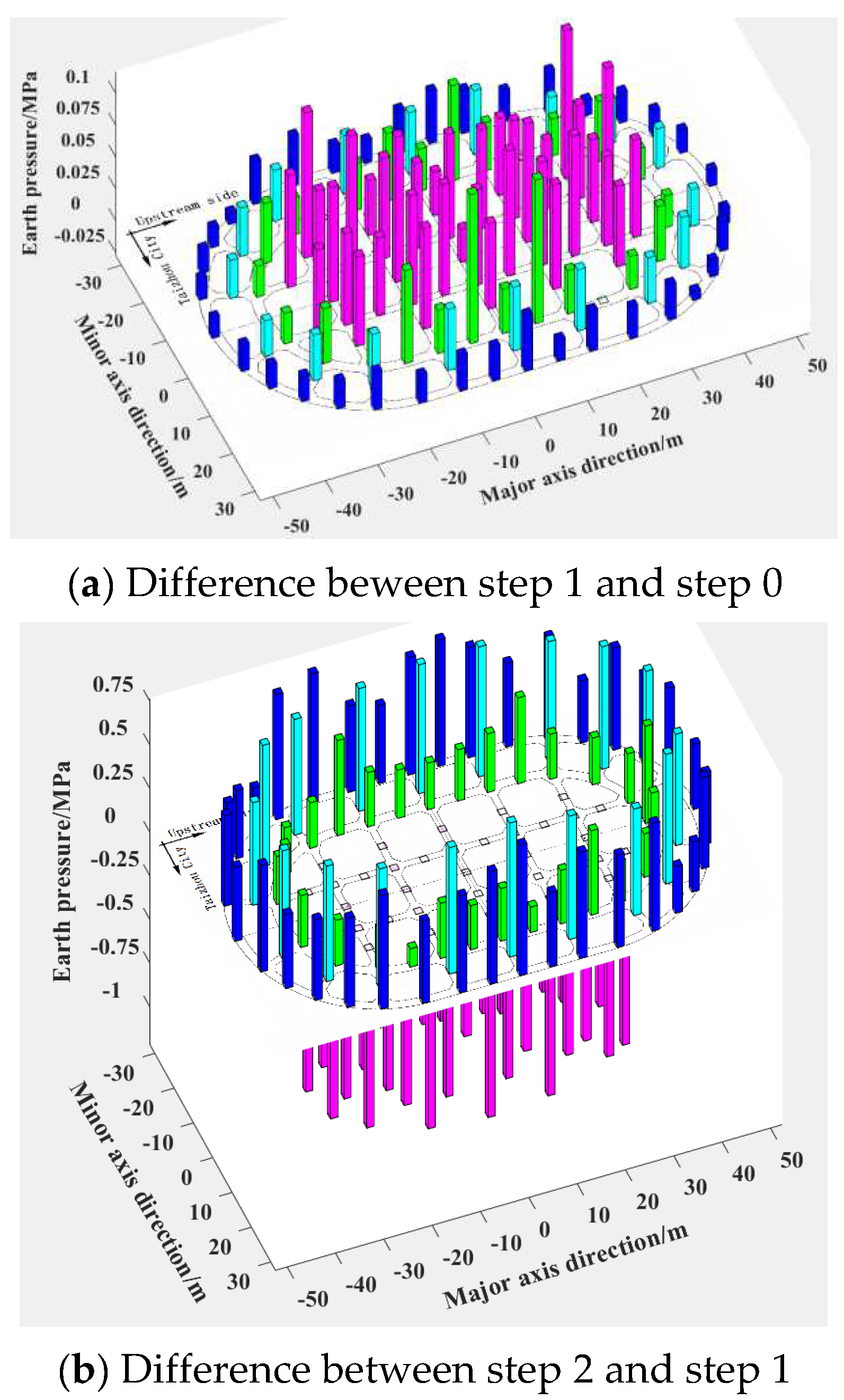
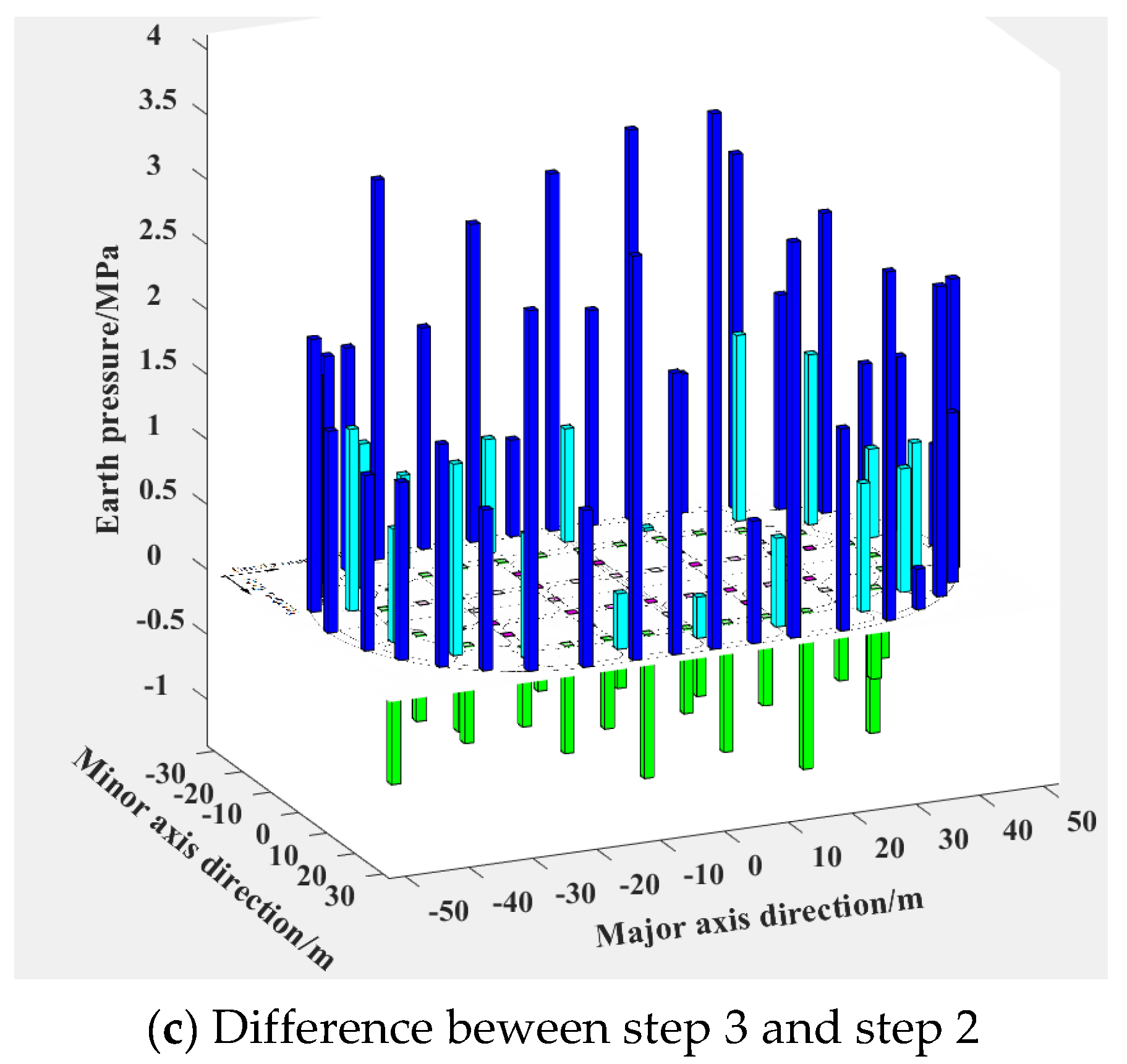
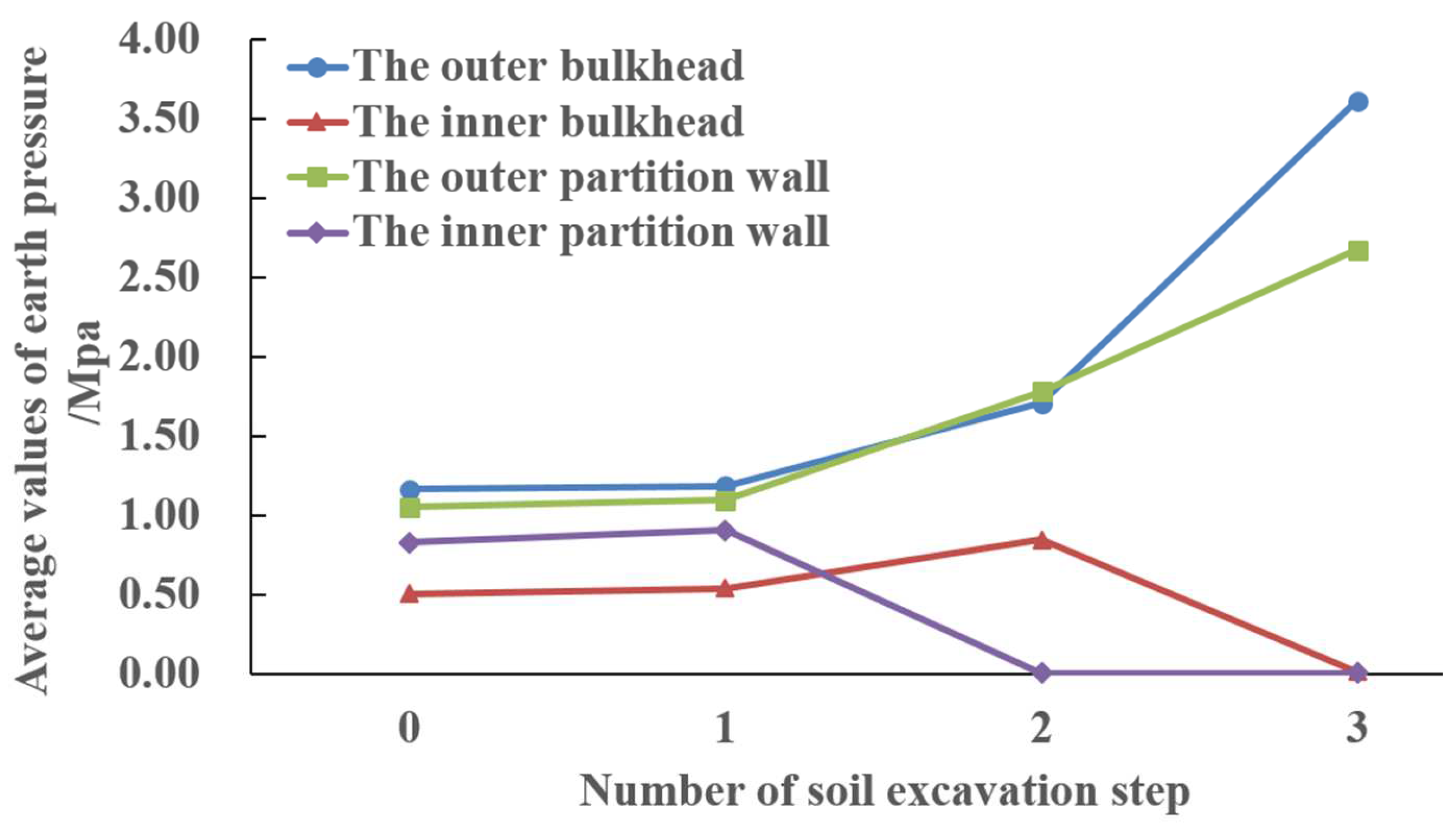
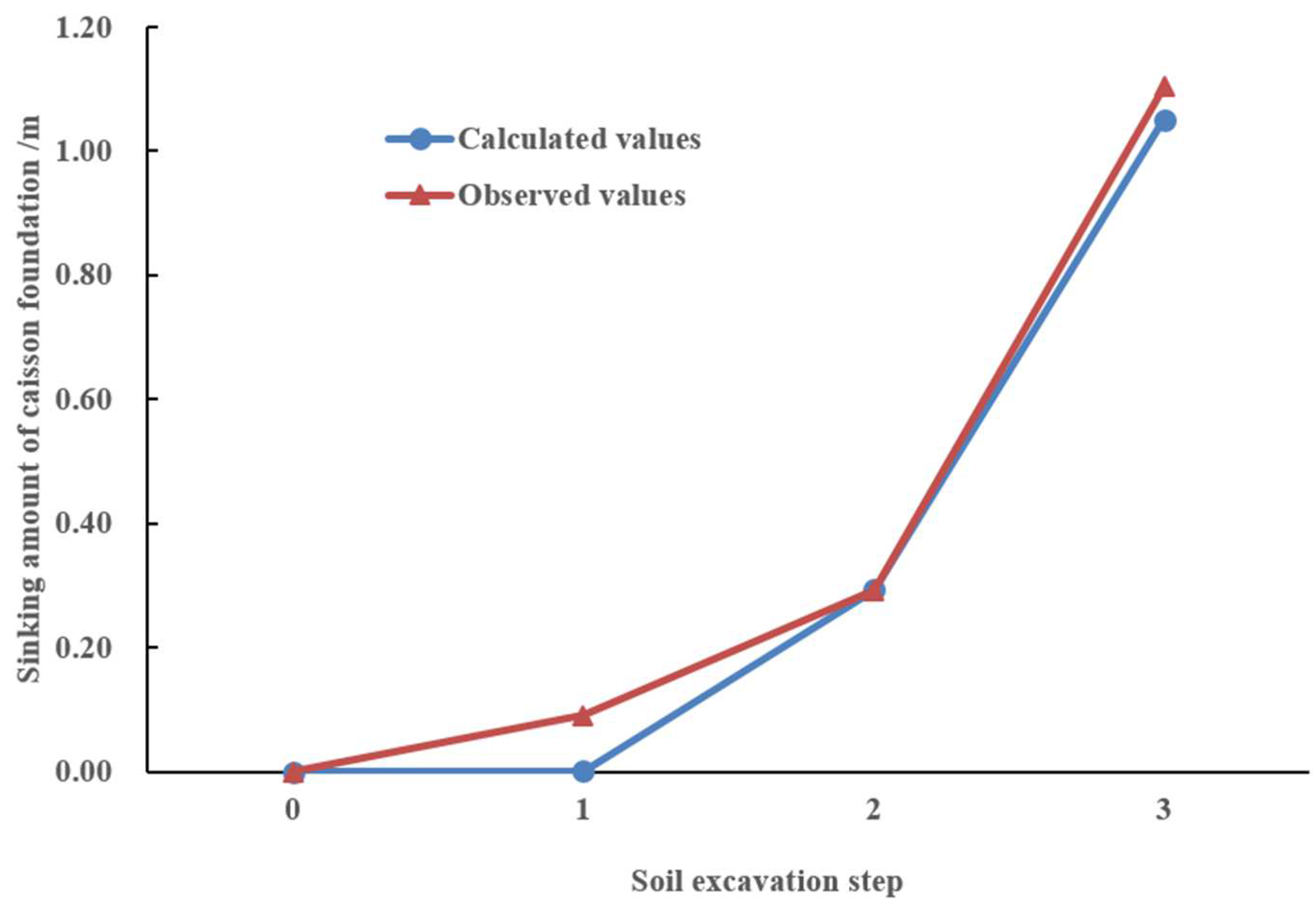
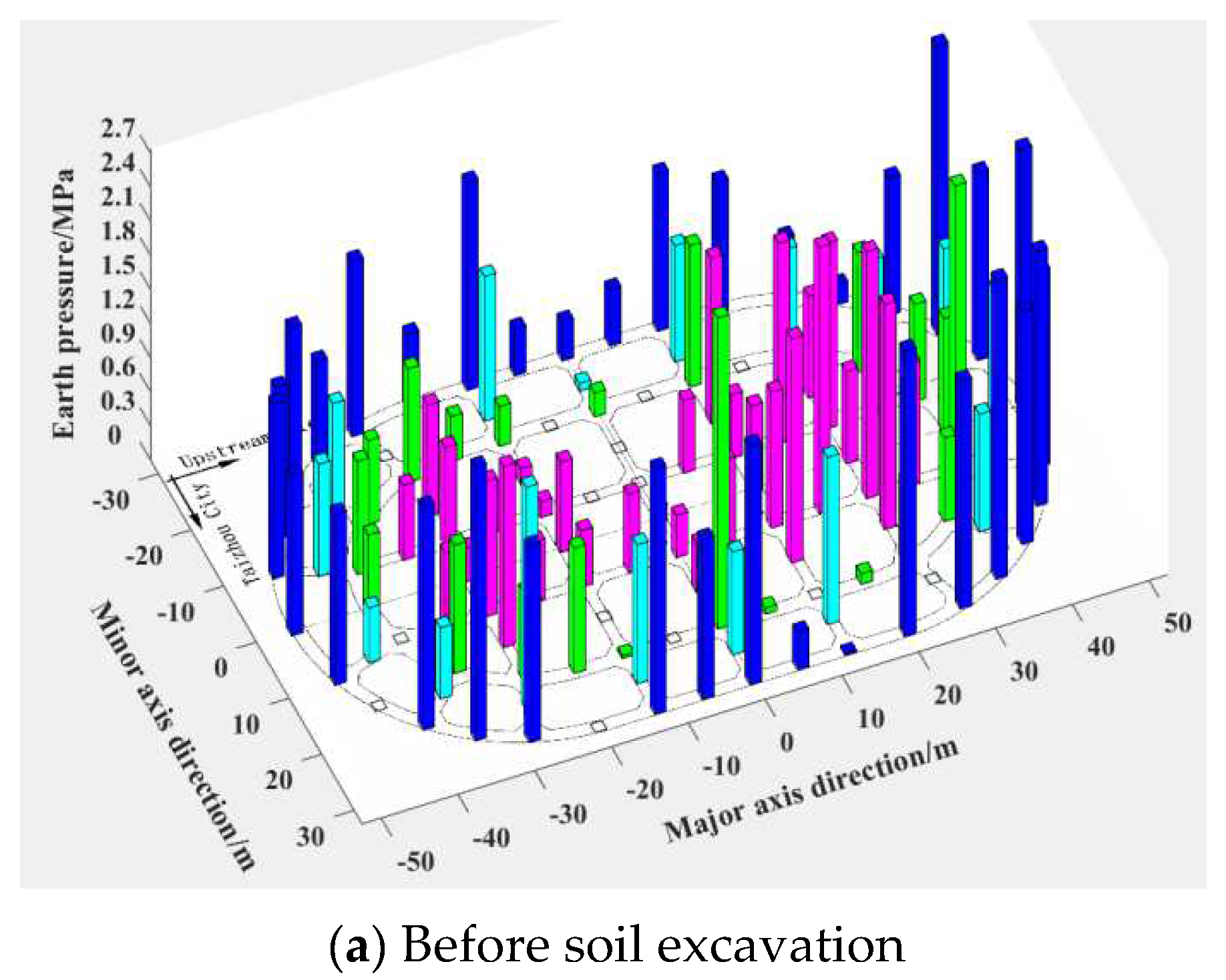
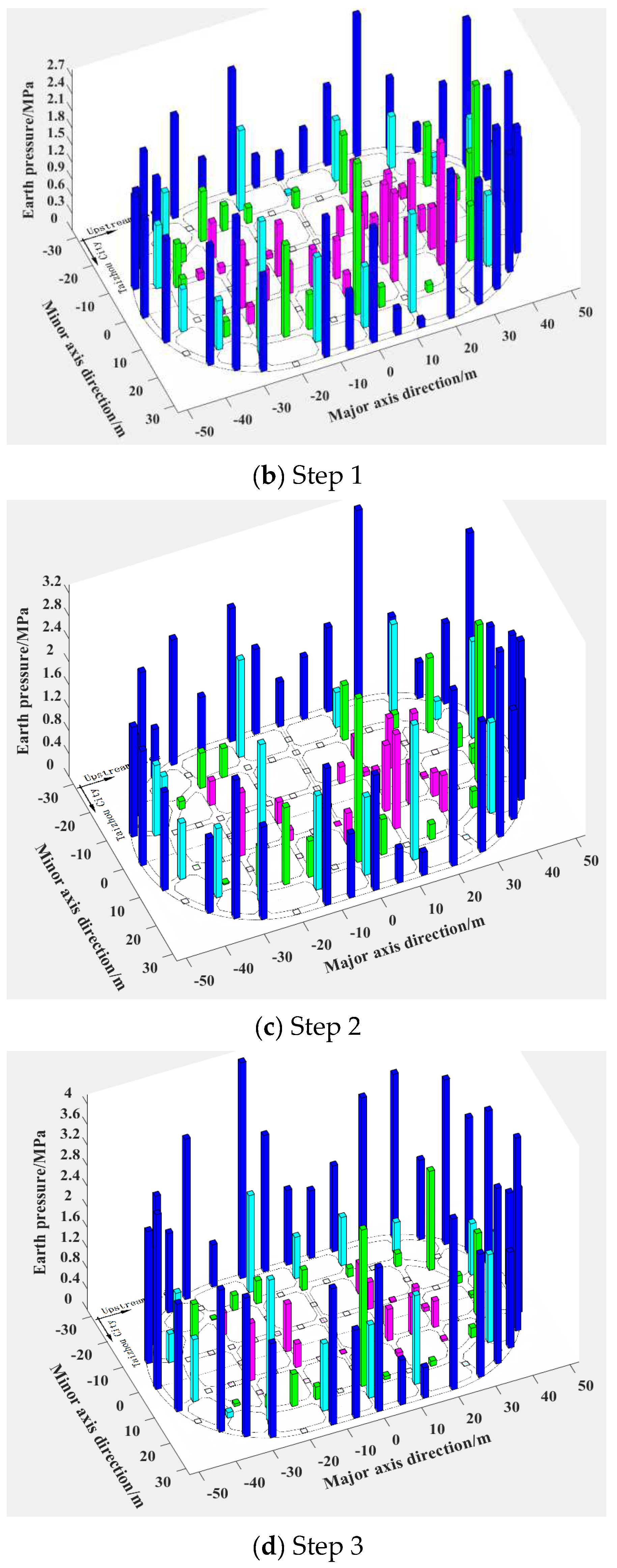
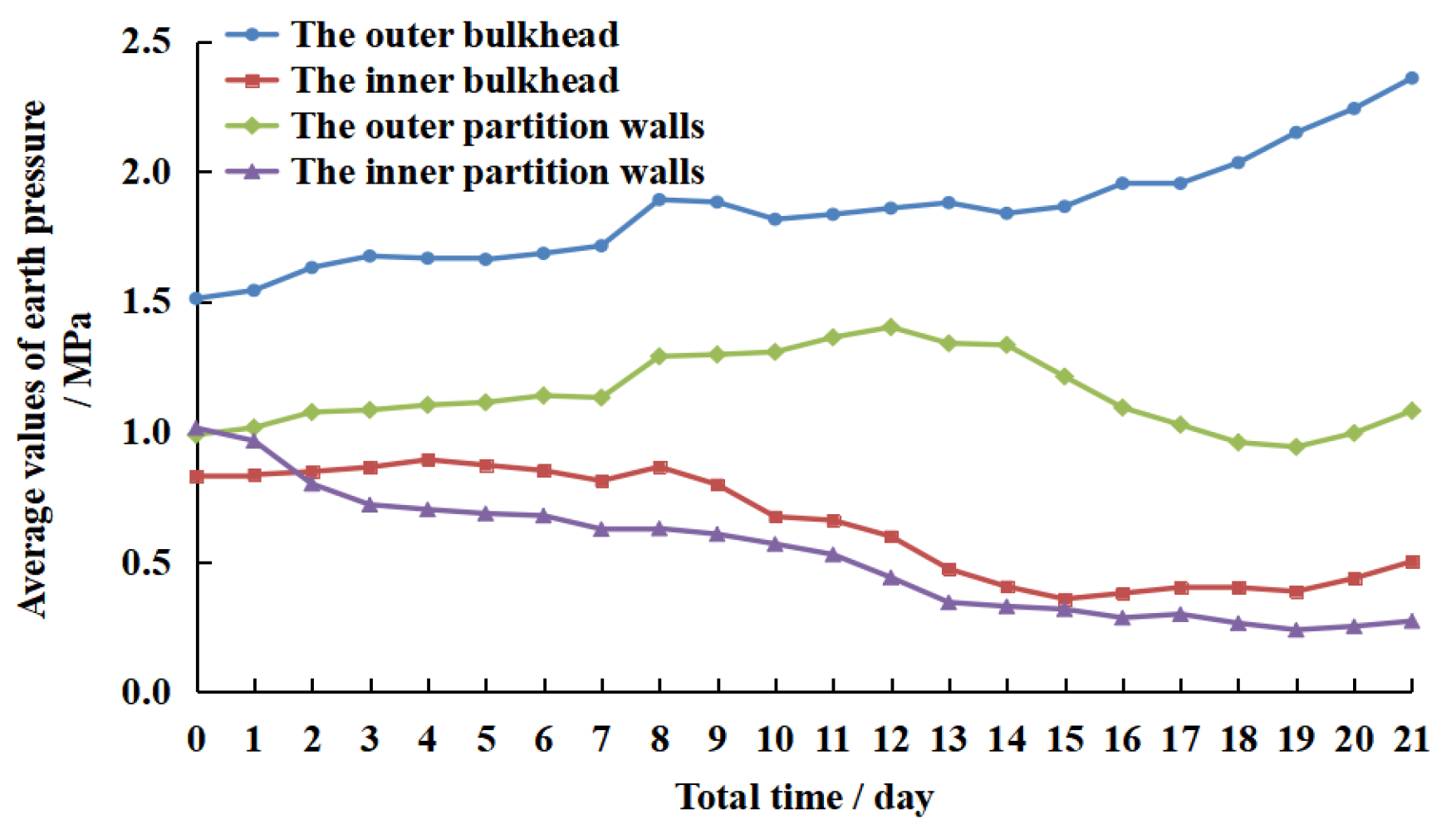
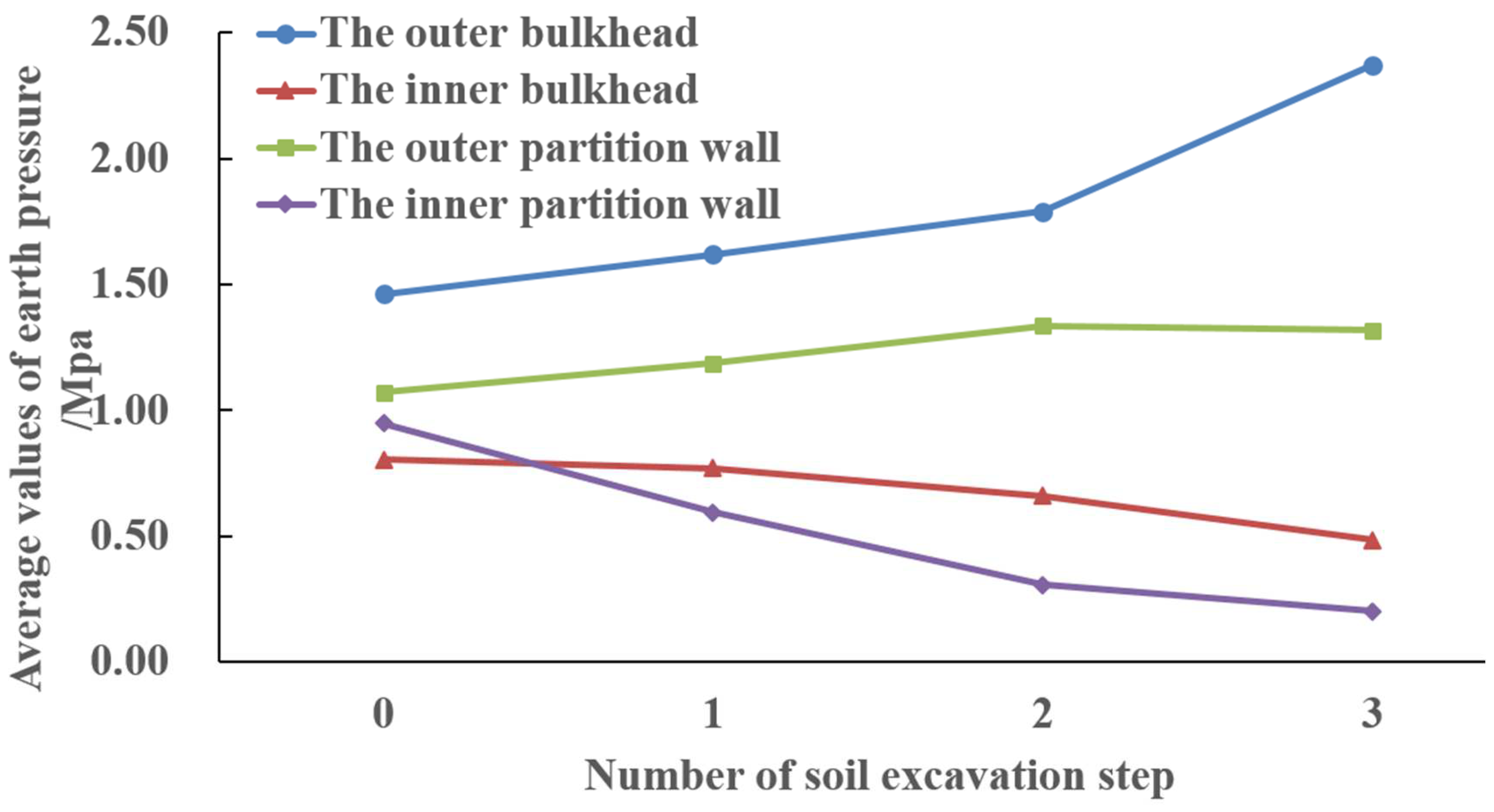
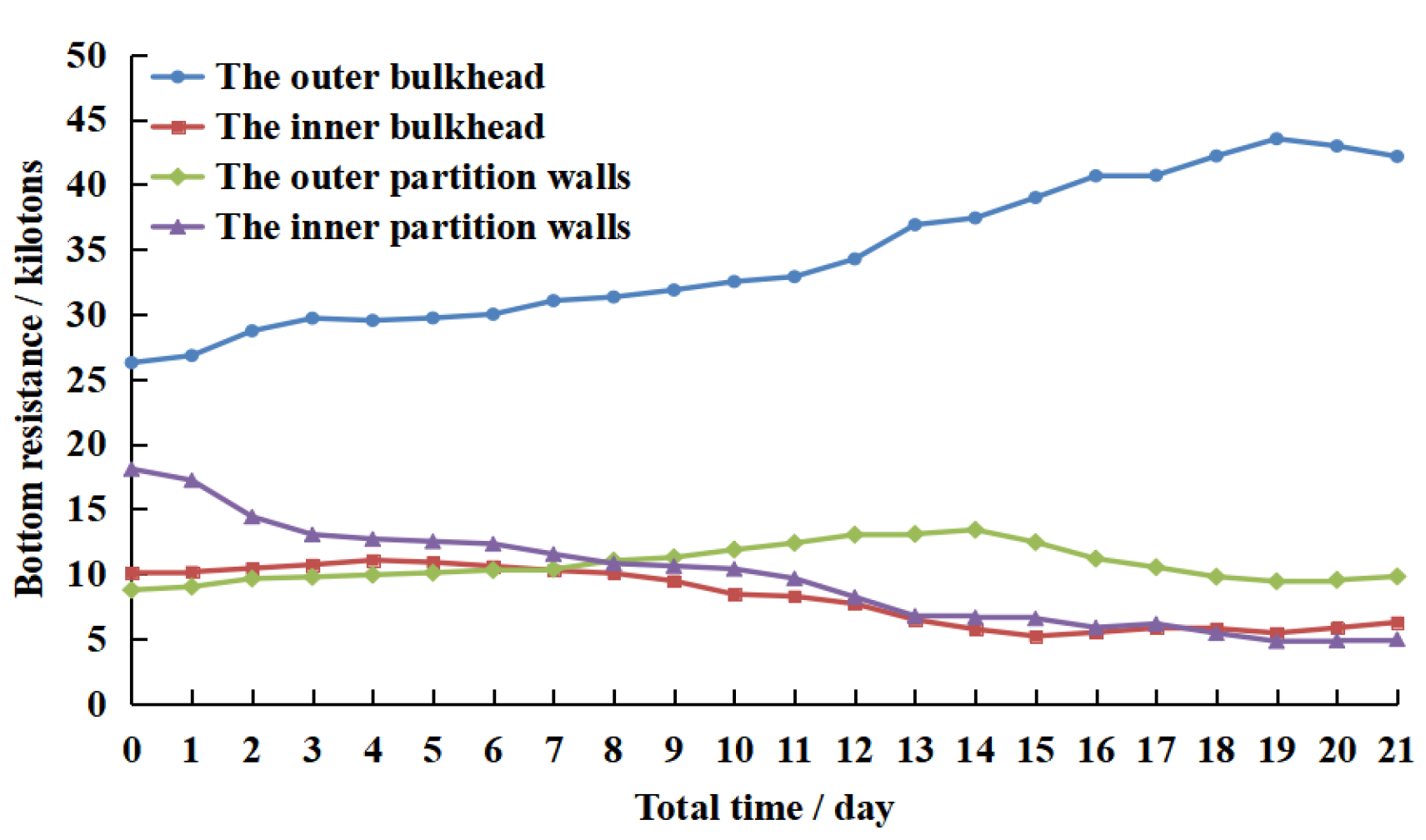
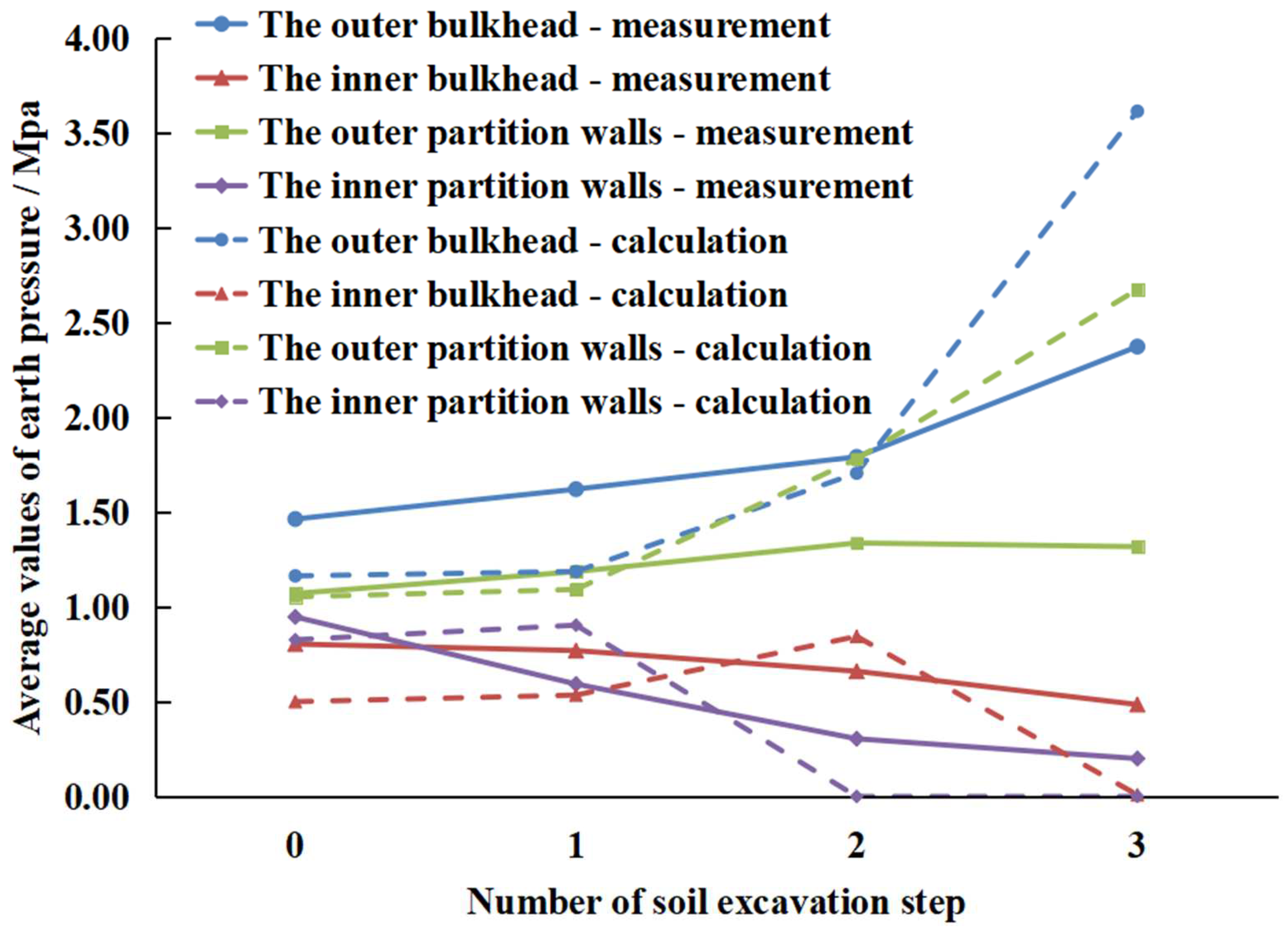
| Serial Number | Stratum | Top Altitude/m | Bottom Altitude/m | Thickness /m | Weight /(kN/m3) | Deformation Modulus /MPa | Poisson’s Ratio | Cohesion /kPa | Internal Friction Angle /(°) |
|---|---|---|---|---|---|---|---|---|---|
| 1 | Silty clay | −18.1 | −22.7 | 4.7 | 19.4 | 8.4 | 0.35 | 28.3 | 11.1 |
| 2 | Loose silt | −22.7 | −28.2 | 5.5 | 20.6 | 18.5 | 0.27 | 5.6 | 31.4 |
| 3 | Hard plastic silty clay | −28.2 | −31.3 | 3.1 | 20.0 | 4.7 | 0.32 | 41.3 | 20.9 |
| 4 | Slightly dense silt | −31.3 | −33.2 | 1.9 | 20.6 | 8.1 | 0.28 | 6.5 | 35.4 |
| 5 | Soft plastic silty clay | −33.2 | −39.7 | 6.5 | 19.0 | 3.8 | 0.34 | 37.9 | 18.1 |
| 6 | Medium dense silt | −39.7 | −48.2 | 8.5 | 20.6 | 9.3 | 0.26 | 5.6 | 31.4 |
| 7 | Dense fine sand | −48.2 | −53.9 | 5.7 | 19.8 | 15.9 | 0.25 | 4.7 | 35.2 |
| 8 | Dense medium sand | −53.9 | −56.3 | 2.4 | 20.0 | 15.9 | 0.25 | 3.9 | 36.5 |
| 9 | Silty clay | −56.3 | −64.9 | 8.6 | 19.0 | 10.2 | 0.34 | 29.1 | 10.5 |
| 10 | Dense fine sand | −64.9 | −69.7 | 4.8 | 19.8 | 31.8 | 0.24 | 2.0 | 35.3 |
| Step | Description | Process Time/Day | Total Time/Day |
|---|---|---|---|
| 1 | Excavating soil to −31.35 m in inner 18 compartment | 7 | 7 |
| 2 | Excavating soil to −31.85 m in inner 18 compartment and blind area under the inner partition walls | 5 | 12 |
| 3 | Excavating soil to −32.85 m in the outer compartment within 2.0 m to the inner bulkhead | 9 | 21 |
| Step Number | Average of Soil Pressure/MPa | |||
|---|---|---|---|---|
| Outer Bulkhead | Inner Bulkhead | Outer Partition | Inner Partition | |
| 0 | 1.46 | 0.81 | 1.07 | 0.95 |
| 1 | 1.62 | 0.77 | 1.19 | 0.59 |
| 2 | 1.79 | 0.66 | 1.34 | 0.31 |
| 3 | 2.37 | 0.49 | 1.32 | 0.20 |
Publisher’s Note: MDPI stays neutral with regard to jurisdictional claims in published maps and institutional affiliations. |
© 2021 by the authors. Licensee MDPI, Basel, Switzerland. This article is an open access article distributed under the terms and conditions of the Creative Commons Attribution (CC BY) license (https://creativecommons.org/licenses/by/4.0/).
Share and Cite
Guo, M.; Dong, X.; Li, J. Study on the Earth Pressure during Sinking Stage of Super Large Caisson Foundation. Appl. Sci. 2021, 11, 10488. https://doi.org/10.3390/app112110488
Guo M, Dong X, Li J. Study on the Earth Pressure during Sinking Stage of Super Large Caisson Foundation. Applied Sciences. 2021; 11(21):10488. https://doi.org/10.3390/app112110488
Chicago/Turabian StyleGuo, Mingwei, Xuechao Dong, and Jiahang Li. 2021. "Study on the Earth Pressure during Sinking Stage of Super Large Caisson Foundation" Applied Sciences 11, no. 21: 10488. https://doi.org/10.3390/app112110488
APA StyleGuo, M., Dong, X., & Li, J. (2021). Study on the Earth Pressure during Sinking Stage of Super Large Caisson Foundation. Applied Sciences, 11(21), 10488. https://doi.org/10.3390/app112110488





